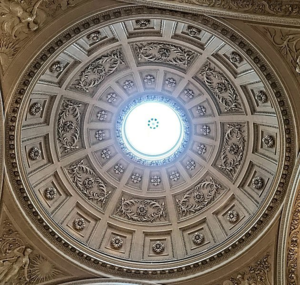Difference between revisions of "Gfelkt hahelesgjios"
(Created page with "The Gfelkt hahelesgjios (/gʷɛɭkt hɐhəɭəsjɘʒɪʊʂ/, Gfiewish for ‘Temple for the neighbor’) is the biggest temple of Aušaj, the capital and biggest city of Lufas...") |
m |
||
| Line 1: | Line 1: | ||
[[File:The dome of Gfelkt hahelesgjios.png|thumbnail|The dome of Gfelkt hahelesgjios]] | |||
The Gfelkt hahelesgjios (/gʷɛɭkt hɐhəɭəsjɘʒɪʊʂ/, Gfiewish for ‘Temple for the neighbor’) is the biggest temple of Aušaj, the capital and biggest city of Lufasa. It is the biggest temple in Lufasa and one of the biggest temples in all of Ystel. Built by Gfiewish missionaries and their contractors in the beginning of the 17th century, it was suppposed to help with spreading the state religion of the newly united Kingdom of Gfiewistan to Lufasa which at the time was part of a recently annexed Gfiewish chiefdom. . | The Gfelkt hahelesgjios (/gʷɛɭkt hɐhəɭəsjɘʒɪʊʂ/, Gfiewish for ‘Temple for the neighbor’) is the biggest temple of Aušaj, the capital and biggest city of Lufasa. It is the biggest temple in Lufasa and one of the biggest temples in all of Ystel. Built by Gfiewish missionaries and their contractors in the beginning of the 17th century, it was suppposed to help with spreading the state religion of the newly united Kingdom of Gfiewistan to Lufasa which at the time was part of a recently annexed Gfiewish chiefdom. . | ||
| Line 14: | Line 15: | ||
However, due to the general lack of success missionaries had in converting people to the state religion of the Kingdom of Gfiewistan, the temple was used by far less people than anticipated and was for centuries usually very empty, with native Lufasans avoiding it as a symbol of foreign suppression of their own religion and culture, and ethnic Gfiewish people preferring smaller temples with a more established and tight-knit community. Only after Lufasan independence in 1852 did this begin to change, with the temple now being a pan-religious house of worship open to everyone. | However, due to the general lack of success missionaries had in converting people to the state religion of the Kingdom of Gfiewistan, the temple was used by far less people than anticipated and was for centuries usually very empty, with native Lufasans avoiding it as a symbol of foreign suppression of their own religion and culture, and ethnic Gfiewish people preferring smaller temples with a more established and tight-knit community. Only after Lufasan independence in 1852 did this begin to change, with the temple now being a pan-religious house of worship open to everyone. | ||
[[Category:Lufasa]] [[Category:Architecture]] [[Category: | [[Category:Lufasa]] [[Category:Architecture]] [[Category:Religion in Ystel]] | ||
Revision as of 21:51, 5 October 2021
The Gfelkt hahelesgjios (/gʷɛɭkt hɐhəɭəsjɘʒɪʊʂ/, Gfiewish for ‘Temple for the neighbor’) is the biggest temple of Aušaj, the capital and biggest city of Lufasa. It is the biggest temple in Lufasa and one of the biggest temples in all of Ystel. Built by Gfiewish missionaries and their contractors in the beginning of the 17th century, it was suppposed to help with spreading the state religion of the newly united Kingdom of Gfiewistan to Lufasa which at the time was part of a recently annexed Gfiewish chiefdom. .
Name
From the Gfiewish point of view, the name references the location of Lufasa and Aušaj in particular as “neighbor” of Gfiewistan, who were hoped would start using the temple eagerly, sooner or later.
From the Lufasan point of view, it reflects instead how the temple was built not really for themselves or their benefit, but instead how it was really constructed for the benefit of their neighbor, the Gfiewish people and the foreign religion these neighbors were trying to introduce, increasingly forcefully.
Architecture and intended use
It has the typical dome architecture common in early modern Gfiewish religious buildings. Right below the open dome stands an eternal flame that can be used to create smaller lights, symbolic guides for you or another person. There are large circular windows on all four sides and circles engraved in the floor and walls. Visitors have to wear a face veil covering their eyes or the entire face to not be blinded by the sunlight, although in modern times many prefer sunglasses. Some devout Iovists prefer a combination.
An additional reason for the veal is increased privacy and anonymity during community gatherings, celebrations or even simple visits to a temple, to ask for advice or for individual prayers. The Temple for the neighbor has for this purpose several smaller rooms in the corners for solitary rites or private meetings. They are connected with underground paths to form a poorly lightened maze-like structure which represent the chaos inherent to life, complementing the many circles of the bright main structure representing order.
Modern use
However, due to the general lack of success missionaries had in converting people to the state religion of the Kingdom of Gfiewistan, the temple was used by far less people than anticipated and was for centuries usually very empty, with native Lufasans avoiding it as a symbol of foreign suppression of their own religion and culture, and ethnic Gfiewish people preferring smaller temples with a more established and tight-knit community. Only after Lufasan independence in 1852 did this begin to change, with the temple now being a pan-religious house of worship open to everyone.
